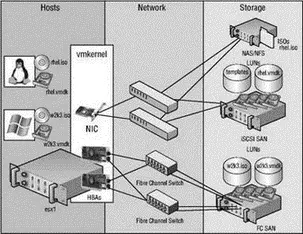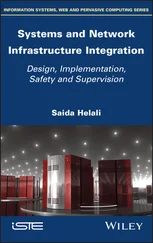Chris McCain - Mastering VMware® Infrastructure3
Здесь есть возможность читать онлайн «Chris McCain - Mastering VMware® Infrastructure3» — ознакомительный отрывок электронной книги совершенно бесплатно, а после прочтения отрывка купить полную версию. В некоторых случаях можно слушать аудио, скачать через торрент в формате fb2 и присутствует краткое содержание. Город: Indianapolis, Год выпуска: 2008, ISBN: 2008, Издательство: WILEY Wiley Publishing, Inc., Жанр: Программы, ОС и Сети, на английском языке. Описание произведения, (предисловие) а так же отзывы посетителей доступны на портале библиотеки ЛибКат.
- Название:Mastering VMware® Infrastructure3
- Автор:
- Издательство:WILEY Wiley Publishing, Inc.
- Жанр:
- Год:2008
- Город:Indianapolis
- ISBN:978-0-470-18313-7
- Рейтинг книги:5 / 5. Голосов: 1
-
Избранное:Добавить в избранное
- Отзывы:
-
Ваша оценка:
- 100
- 1
- 2
- 3
- 4
- 5
Mastering VMware® Infrastructure3: краткое содержание, описание и аннотация
Предлагаем к чтению аннотацию, описание, краткое содержание или предисловие (зависит от того, что написал сам автор книги «Mastering VMware® Infrastructure3»). Если вы не нашли необходимую информацию о книге — напишите в комментариях, мы постараемся отыскать её.
Mastering VMware® Infrastructure3 — читать онлайн ознакомительный отрывок
Ниже представлен текст книги, разбитый по страницам. Система сохранения места последней прочитанной страницы, позволяет с удобством читать онлайн бесплатно книгу «Mastering VMware® Infrastructure3», без необходимости каждый раз заново искать на чём Вы остановились. Поставьте закладку, и сможете в любой момент перейти на страницу, на которой закончили чтение.
Интервал:
Закладка:
Master It Virtual machines need to communicate with physical servers on the production network.
Master It Service console communication must occur on a dedicated management network.
Master It A dedicated network has been implemented to support VMotion.
Master It A dedicated storage network has been implemented to support communication to iSCSI and NFS storage devices.
Create and manage NIC teams. NIC teams offer the opportunity for redundancy and load balancing of network traffic. NIC teams offer three load-balancing policies: port-based, source MAC-based, and IP hash-based load balancing.
Master It Virtual machines with one virtual network adapter must be capable of using multiple physical network adapters when connecting to multiple network destinations.
Master It A vSwitch configured with a NIC team needs to experience failback when a physical network adapter is repaired after failover.
Master It Bandwidth available on multiple physical network adapters must be accessible to a single virtual network adapter on a virtual machine.
Master It Discovery time after a failover event on a NIC team needs to be minimized to prevent unnecessary delays.
Create and manage virtual LANs (VLANs). The use of vLANs in a virtual networking architecture offers security, scalability, and communication efficiency.
Master It A vSwitch needs to be configured with two vLANs named VLAN101 and VLAN102.
Master It A vSwitch is configured with vLANs identical to those configured on the physical switch to which it is connected; however, traffic between the two switches is not functioning.
Configure virtual switch security policies. Virtual switch security comes in a tight little package that includes three specific security settings that deal with identifying and processing traffic through a virtual switch. Promiscuous Mode, MAC Address Changes, and Forged Transmits each provides a securable vSwitch architecture, which ensures that only the right systems are sending and receiving traffic as expected.
Master It A virtual machine with an installed intrusion detection system (IDS) needs to "sniff" the traffic passing through a vSwitch but the vSwitch is not configured to allow virtual machines to identify all traffic on the switch. You need to allow the functionality of the IDS while minimizing the security impact on the network.
Master It An administrator of a Windows Server 2003 computer has changed the IP address of the guest operating system from the properties of the network adapter. The administrator now states that the Windows Server 2003 computer cannot communicate with requesting clients. You identify that the virtual machine port group to which the virtual machine is connected does not permit the vSwitch to send traffic when the effective and initial MAC addresses do not match.
Chapter 4
Creating and Managing Storage Devices
Fibre channel? iSCSI? NAS? Should you use all three? Is one better than the others? Should you create a few large LUNs? Should you create smaller LUNs? Where do you put your ISO files? Answers to all these common questions lie ahead as we dive into the vast array of storage options, architectures, and configuration settings for ESX Server. In this chapter you will learn to:
♦ Differentiate among the various storage options available to VI3
♦ Design a storage area network for VI3
♦ Configure and manage Fibre Channel and iSCSI storage networks
♦ Configure and manage NAS storage
♦ Create and manage VMFS volumes
Understanding VI3 Storage Options
VMware Infrastructure 3 (VI3) offers several options for deploying a storage configuration as the back-end to an ESX Server implementation. These options include storage for virtual machines, ISO images, or templates for server provisioning. An ESX Server can have one or more storage options available to it, including:
♦ Fibre Channel storage
♦ iSCSI software-initiated storage
♦ iSCSI hardware-initiated storage
♦ Network Attached Storage (NAS)
♦ Local storage
ESX Server can take advantage of multiple storage architectures within the same host or even for the same virtual machine. ESX Server uses a proprietary file system called VMware File System (VMFS) that provides significant benefits for storing and managing virtual machine files. The virtual machines hosted by an ESX Server can have the associated virtual machine disk files (.vmdk) or mounted CD/DVD-ROM images (.iso) stored in different locations on different storage devices. Figure 4.1 shows an ESX Server host with multiple storage architectures. A Windows virtual machine has the virtual machine disk and CD-ROM image file stored on two different Fibre Channel storage area network (SAN) logical unit numbers (LUNs) on the same storage device. At the same time, a Linux virtual machine stores its virtual disk files on an iSCSI SAN LUN and its CD-ROM images on an NAS device.

Figure 4.1An ESX Server host can be configured with multiple storage options for hosting files used by virtual machines, ISO images, or templates.
During installation, an ESX Server host is configured by default with a local VMFS storage location, named Storage1 by default. The value of this local storage, however, is severely diminished because of the inability to support VMotion, DRS, or HA, and therefore should only be used for non-mission-critical virtual machines or templates and ISO images that are not required by other ESX hosts.
For this reason, when you're sizing a new ESX host, it is not important to dedicate time and money to large storage pools connected to the internal controllers of the host. Investing in large RAID 5, RAID 1+0, or RAID 0+1 volumes for ESX hosts is extremely unnecessary. In order for you to gain the full benefits of virtualization, the virtual machine disk files must reside on a shared storage device that is accessible by multiple ESX hosts. Direct any fiscal and administrative attention to memory and CPU sizing, or even network adapters, but not to locally attached hard drives.
The purpose of this chapter is to answer all your questions about deploying, configuring, and managing a back-end storage solution for your virtualized environment. Ultimately, each implementation will differ, and therefore the various storage architectures available might be the proper solution in one scenario but not in another. As you'll see, each of the storage solutions available to VI3 provides its own set of advantages and disadvantages.
Choosing the right storage technology for your infrastructure begins with a strong understanding of each technology and an intimate knowledge of the systems that will be virtualized as part of the VI3 deployment. Table 4.1 outlines the features of the three shared storage technologies.
Table 4.1: Features of Shared Storage Technologies
| Feature | Fibre Channel | iSCSI | NAS/NFS |
|---|---|---|---|
| Ability to format VMFS | Yes | Yes | No |
| Ability to hold VM files | Yes | Yes | Yes |
| Ability to boot ESX | Yes | Yes | No |
| VMotion, DRS, HA | Yes | Yes | Yes |
| Microsoft clustering | Yes | No | No |
| VCB | Yes | Yes | No |
| Templates, ISOs | Yes | Yes | Yes |
| Raw device mapping | Yes | Yes | No |
As of the writing of this book, VMware had not yet approved support for building Microsoft server clusters with virtual machines running on ESX Server 3.5. All previous versions up to 3.5 offered support, and once VMware has performed due diligence in testing server clusters on the latest version, it is assumed that the support will continue.
Читать дальшеИнтервал:
Закладка:
Похожие книги на «Mastering VMware® Infrastructure3»
Представляем Вашему вниманию похожие книги на «Mastering VMware® Infrastructure3» списком для выбора. Мы отобрали схожую по названию и смыслу литературу в надежде предоставить читателям больше вариантов отыскать новые, интересные, ещё непрочитанные произведения.
Обсуждение, отзывы о книге «Mastering VMware® Infrastructure3» и просто собственные мнения читателей. Оставьте ваши комментарии, напишите, что Вы думаете о произведении, его смысле или главных героях. Укажите что конкретно понравилось, а что нет, и почему Вы так считаете.












